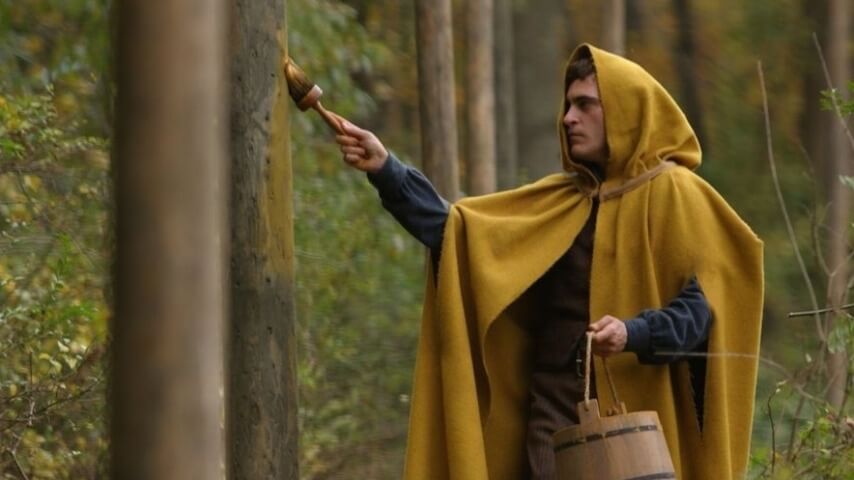The original poster features a disembodied pair of hands holding a piece of parchment with rules of engagement: “I) Let the bad color not be seen, it attracts them. II) Never enter the woods, that is where they wait. III) Heed the warning bell, for they are coming.” It’s no surprise, then, that people were disappointed when The Village turned out to be not so much a period creature feature but something closer to a political allegory, with shades of folk horror and a touch of romance. That’s hard to convey on a poster. It’s even harder to explain the film’s meaning and central themes when understanding them depends on knowing the hidden truth about the village itself.
Is a spoiler warning required for a 20-year-old film? Just in case, consider this your warning that I’m about to spoil the hell out of The Village. Or maybe not. At least, not in the traditional sense of the word. If you haven’t seen it and have no idea how it ends, maybe knowing the twist won’t actually spoil the experience of watching it at all, but instead make it more enjoyable.
Essentially, The Village is about the lengths humans will go to in order to eradicate every negative aspect of life—want, crime, grief, violence—and our ultimate inability to do so, no matter how hard we try. It’s about the limits of faith, a theme Shyamalan returns to frequently, and how it can be used as a tool of control.
The film begins with a funeral for a child. It’s tragic, of course, but there’s another layer that isn’t clear unless you’ve seen the entire film: It’s exactly the kind of trauma that the “elders” were trying to run from when they left “the towns” behind in the 1980s and set up their idealized, self-reliant society in the middle of a Pennsylvania wildlife preserve. It’s the ultimate patriarchal fantasy, an isolationist cult that mimics the America many conservatives picture when they talk about making it great again. But it’s all a farce. They have to hide this truth and make up stories about threatening creatures roaming the woods to keep the children in line, or as Edward Walker (William Hurt) puts it, to protect their “innocence.” But the ruse (the success of which depends entirely on Walker’s family fortune back in the real world) directly leads to the death of at least two of their children and, by the end of the film, leaves one in dire need of modern medical intervention.
Though there aren’t actually any monsters in the woods, Shyamalan effectively uses color (particularly those rich shades of yellow and red) and meticulously framed shots to convey the idea that something very real and scary lurks there. The woods have always been a powerful allegory in film and literature, and Shyamalan follows in that tradition by having them represent the uncomfortable realities of life lurking in the distance. You cannot escape death by hiding behind a wall. Violence is part of human nature. Grief waits patiently beyond the treeline for its time to appear. No matter where you go, you take your trauma with you. Yet, it’s impossible to fully understand any of those deeper ideas unless you know the origin story of the village, and what Walker and the others set out to do when they established it.
Do multiple watches ever make The Village click? Or even make sense? I won’t go that far. There are still annoying logical inconsistencies, gaping plot holes, and things left unexplained. Why did the elders go to such elaborate and dramatic lengths to keep up their ruse? How did they go for so long without anyone letting the truth slip? Why didn’t Walker or one of the other elders make the journey through the woods instead of Ivy, if they all knew the secret already? No amount of time or distance is going to fix those issues.
But despite these problems, and a structure that undermines its power, The Village deserves to be reconsidered for its isolated moments of beauty and poignancy, moments that prove Shyamalan to be a masterful visual storyteller. Legendary cinematographer Roger Deakins gives the film a lovely, painterly quality with his atmospheric lighting designs. He relies on practical sources like oil lamps and candles indoors, while diffusing the sunlight outdoors to create an overcast look. That melancholy tone is enhanced by James Newton Howard’s resonant score, full of melodic strings and dissonant harmonies that hint at something sinister underlying the pastoral tranquility of this rural community. And, of course, there are the extraordinary performances of the cast. Bryce Dallas Howard is incandescent as Ivy, a blind character who can see people for who they really are. Joaquin Phoenix plays her sweetheart Lucius as a stalwart man of few words, but he wears his heart on his sleeve. And as the developmentally disabled Noah, Adrien Brody is an unpredictable loose cannon you can’t help but sympathize with, even when he commits horrific acts. William Hurt and Sigourney Weaver anchor the film with their gravitas. The bench of talent is so deep here that we get Brendan Gleeson, Judy Greer, Cherry Jones, and Jesse Eisenberg in supporting roles (Eisenberg’s role amounts to little more than a featured extra, but you can’t miss him). Not one of them gives anything less than a thoroughly compelling turn.
Perhaps if Shyamalan had made The Village later in his career, he would have handled the story more deftly. Perhaps if audiences hadn’t been set up with false expectations the twist wouldn’t have been so disappointing. We can’t go back and change the past, but now that Shyamalan is known for more than just his twist endings, we can give The Village the credit it deserves.


 Keep scrolling for more great stories from A.V. Club.
Keep scrolling for more great stories from A.V. Club.